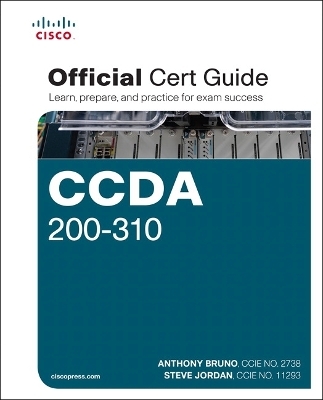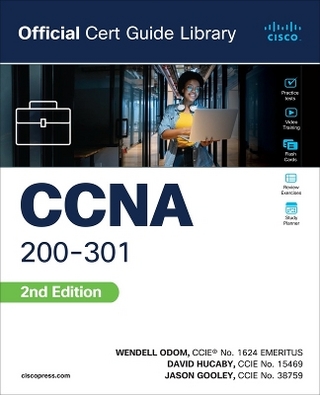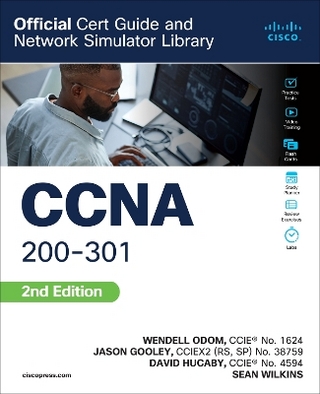
CCDA 200-310 Official Cert Guide
Cisco Press
978-1-58714-454-7 (ISBN)
Trust the best-selling Official Cert Guide series from Cisco Press to help you learn, prepare, and practice for exam success. They are built with the objective of providing assessment, review, and practice to help ensure you are fully prepared for your certification exam.
CCDA 200-310 Official Cert Guide presents you with an organized test preparation routine through the use of proven series elements and techniques. “Do I Know This Already?” quizzes open each chapter and allow you to decide how much time you need to spend on each section. Exam topic lists make referencing easy. Chapter-ending Exam Preparation Tasks help you drill on key concepts you must know thoroughly.
Master Cisco CCDA 200-310 exam topics
Assess your knowledge with chapter-opening quizzes
Review key concepts with exam preparation tasks
Practice with realistic exam questions
CCDA 200-310 Official Cert Guide focuses specifically on the objectives for the newest Cisco CCDA DESGN exam. Expert networking consultants Anthony Bruno and Steve Jordan share preparation hints and test-taking tips, helping you identify areas of weakness and improve both your conceptual knowledge and hands-on skills. Material is presented in a concise manner, focusing on increasing your understanding and retention of exam topics.
Your downloadable Pearson IT Certification Practice Test engine allows you to focus on individual topic areas or take a complete, timed exam. The assessment engine also tracks your performance and provides feedback on a module-by-module basis, laying out a complete assessment of your knowledge to help you focus your study where it is needed most.
Well-regarded for its level of detail, assessment features, comprehensive design scenarios, and challenging review questions and exercises, this official study guide helps you master the concepts and techniques that will allow you to succeed on the exam the first time.
The official study guide helps you master all the topics on the newest CCDA DESGN exam, including:
Design methodologies, including PBM, network characterization, and top-down/bottom-up approaches
Design objectives: modularity, hierarchy, scalability, resilience, fault domains
Addressing and routing protocols in existing networks
Enterprise network design: campus, enterprise, and branch
Expanding existing networks: wireless, security, collaboration, virtualization, programmability, data centers, and more
CCDA 200-310 Official Cert Guide is part of a recommended learning path from Cisco that includes simulation and hands-on training from authorized Cisco Learning Partners and self-study products from Cisco Press. To find out more about instructor-led training, e-learning, and hands-on instruction offered by authorized Cisco Learning Partners worldwide, please visit http://www.cisco.com/web/learning/index.html.
The print edition of the CCDA 200-310 Official Cert Guide contains two free, complete practice exams.
Also available from Cisco Press for Cisco CCDA study is the CCDA 200-310 Official Cert Guide Premium Edition eBook and Practice Test. This digital-only certification preparation product combines an eBook with enhanced Pearson IT Certification Practice Test.
This integrated learning package:
Allows you to focus on individual topic areas or take complete, timed exams
Includes direct links from each question to detailed tutorials to help you understand the concepts behind the questions
Provides unique sets of exam-realistic practice questions
Tracks your performance and provides feedback on a module-by-module basis, laying out a complete assessment of your knowledge to help you focus your study where it is needed most
Anthony Bruno, CCIE No. 2738, is a Consulting Director with BT with more than 20 years of experience in the internetworking field. Previously, he worked for International Network Services, Lucent Technologies, and as a captain in the U.S. Air Force. His other industry certifications include CCDP, PMP, CCNP Security, Cisco Certified Business Value Practitioner, Cisco Data Center Network Infrastructure Specialist, Cisco Security Solutions & Design Specialist, and ITILv3 Foundation. He has consulted for many enterprise and service provider customers in the design, implementation, and optimization of large-scale networks. Anthony leads architecture and design teams in building nextgeneration networks for his customers. He completed his Master of Science in Electrical Engineering at the University of Missouri—Rolla in 1994 and his Bachelor of Science in Electrical Engineering at the University of Puerto Rico—Mayaguez in 1990. He is also a part-time instructor for the University of Phoenix—Online, teaching networking courses. Outside of work Anthony enjoys running marathons, Spartan obstacle races, and Olympic and Ironman distance triathlons. Steve Jordan, CCIE No. 11293, is a Senior Technology Manager with Accudata Systems and has 20 years experience in the field of internetworking. For the last 10 years, Steve has specialized in data center architectures involving compute, network, storage, virtualization, and SDN. Over the years, Steve has worked with many enterprise and service provider customers in both pre-sales and post-sales engineering and architecture roles, along with working at several Cisco Gold Partners. He has extensive experience in data center architecture and design and has implemented solutions in many financial, energy, retail, healthcare, education, and telecommunications industries. Steve is a 10-Year triple CCIE in the tracks of Routing & Switching, Storage Networking, and Data Center. His other certifications include VMware VCIX-NV, VCP-NV, VCP4-DCV, VCP5-DCV, CCDP, CCNP, ACI-SE, and ACI-FE. Steve lives in Houston, Texas, with his wife and three sons. When he is not working on technology, Steve can be found traveling to new places, finding great food, and listening to live music. Steve was also the coauthor for the previous editions of the CCDA Official Cert Guide.
Introduction xxxvi
Part I General Network Design
Chapter 1 Network Design Methodology 3
“Do I Know This Already?” Quiz 3
Foundation Topics 6
Cisco Architectures for the Enterprise 6
Borderless Networks Architecture 7
Collaboration and Video Architecture 8
Data Center and Virtualization Architecture 8
Cisco Design Lifecycle: Plan, Build, Manage 9
Plan Phase 10
Build Phase 11
Manage Phase 11
Prepare, Plan, Design, Implement, Operate, and Optimize Phases 12
Prepare Phase 14
Plan Phase 14
Design Phase 14
Implement Phase 15
Operate Phase 15
Optimize Phase 15
Summary of PPDIOO Phases 15
Project Deliverables 16
Design Methodology 16
Identifying Customer Design Requirements 17
Characterizing the Existing Network 18
Steps in Gathering Information 19
Network Audit Tools 19
Network Checklist 23
Designing the Network Topology and Solutions 24
Top-Down Approach 24
Pilot and Prototype Tests 25
Design Document 25
References and Recommended Reading 26
Exam Preparation Tasks 28
Review All Key Topics 28
Complete Tables and Lists from Memory 28
Define Key Terms 28
Q&A 28
Chapter 2 Network Design Models 39
“Do I Know This Already?” Quiz 39
Foundation Topics 41
Hierarchical Network Models 41
Benefits of the Hierarchical Model 41
Hierarchical Network Design 42
Hierarchical Model Examples 46
Hub-and-Spoke Design 48
Collapsed Core Design 49
Cisco Enterprise Architecture Model 49
Enterprise Campus Module 50
Enterprise Edge Area 52
Service Provider Edge Module 56
Remote Modules 57
High Availability Network Services 59
Workstation-to-Router Redundancy and LAN High Availability Protocols 60
Server Redundancy 62
Route Redundancy 63
Link Media Redundancy 65
References and Recommended Reading 66
Exam Preparation Tasks 68
Review All Key Topics 68
Complete Tables and Lists from Memory 68
Define Key Terms 68
Q&A 68
Part II LAN and WAN Design
Chapter 3 Enterprise LAN Design 81
“Do I Know This Already?” Quiz 81
Foundation Topics 83
LAN Media 83
Ethernet Design Rules 83
Gigabit Ethernet Design Rules 85
10 Gigabit Ethernet Design Rules 87
EtherChannel 88
Comparison of Campus Media 88
LAN Hardware 89
Repeaters 89
Hubs 89
Bridges 89
Switches 90
Routers 91
Layer 3 Switches 92
Campus LAN Design and Best Practices 93
Best Practices for Hierarchical Layers 94
STP Design Considerations 101
Cisco STP Toolkit 103
VLAN and Trunk Considerations 105
Unidirectional Link Detection (UDLD) Protocol 105
Large-Building LANs 106
Enterprise Campus LANs 107
Medium-Size LANs 109
Small and Remote Site LANs 110
Server Farm Module 110
Enterprise Data Center Infrastructure 111
Campus LAN QoS Considerations 111
Multicast Traffic Considerations 113
References and Recommended Readings 114
Exam Preparation Tasks 115
Review All Key Topics 115
Complete Tables and Lists from Memory 115
Define Key Terms 115
Q&A 115
Chapter 4 Data Center Design 127
“Do I Know This Already?” Quiz 127
Foundation Topics 130
Enterprise DC Architecture 130
Data Center Foundation Components 131
Data Center Topology Components 132
Data Center Network Programmability 133
Challenges in the DC 136
Data Center Facility Aspects 136
Data Center Space 138
Data Center Power 139
Data Center Cooling 140
Data Center Heat 141
Data Center Cabling 141
Enterprise DC Infrastructure 143
Data Center Storage 144
Data Center Reference Architecture 146
Defining the DC Access Layer 147
Defining the DC Aggregation Layer 148
Defining the DC Core Layer 149
Security in the DC 150
Fabric Extenders 151
Virtualization Overview 151
Challenges 151
Defining Virtualization and Benefits 151
Virtualization Risks 152
Types of Virtualization 152
Virtualization Technologies 153
VSS 153
VRF 154
vPC 154
Device Contexts 155
Server Virtualization 155
Server Scaling 155
Virtual Switching 156
Network Virtualization Design Considerations 156
Data Center Interconnect 157
DCI Use Cases 157
DCI Transport Options 158
DCI L2 Considerations 159
Load Balancing in the DC 159
Application Load Balancing 159
Network Load Balancing 160
References and Recommended Readings 160
Exam Preparation Tasks 161
Review All Key Topics 161
Complete Tables and Lists from Memory 162
Define Key Terms 162
Q&A 162
Chapter 5 Wireless LAN Design 167
“Do I Know This Already?” Quiz 167
Foundation Topics 169
Wireless LAN Technologies 169
WLAN Standards 169
Service Set Identifier 171
WLAN Layer 2 Access Method 172
WLAN Security 172
Cisco Unified Wireless Network 175
Cisco UWN Architecture 175
Autonomous Access Points 176
Centralized WLAN Architecture 177
LWAPP 177
WLAN Authentication 182
WLAN Controller Components 183
Roaming and Mobility Groups 186
WLAN Design 190
Controller Redundancy Design: Deterministic vs. Dynamic 190
Radio Management and Radio Groups 192
RF Site Survey 194
Using EoIP Tunnels for Guest Services 194
Wireless Mesh for Outdoor Wireless 195
Campus Design Considerations 196
Branch Design Considerations 199
References and Recommended Readings 201
Exam Preparation Tasks 203
Review All Key Topics 203
Complete Tables and Lists from Memory 203
Define Key Terms 203
Q&A 204
Chapter 6 WAN Technologies and the Enterprise Edge 215
“Do I Know This Already?” Quiz 215
Foundation Topics 218
WAN and Enterprise Edge Overview 218
WAN Defined 218
WAN Edge Module 219
Enterprise Edge Modules 219
WAN Transport Technologies 220
ISDN 221
Digital Subscriber Line 222
Cable 222
Wireless 223
Frame Relay 224
Time-Division Multiplexing 225
Metro Ethernet 225
SONET/SDH 225
Multiprotocol Label Switching (MPLS) 226
Dark Fiber 227
Dense Wavelength-Division Multiplexing 228
Ordering WAN Technology and Contracts 228
WAN and Edge Design Methodologies 229
Response Time 230
Throughput 231
Reliability 231
Bandwidth Considerations 231
WAN Link Categories 232
Optimizing Bandwidth Using QoS 233
DMZ Connectivity 236
Segmenting DMZs 237
DMZ Services 238
Internet Connectivity 238
Centralized Internet (Branch) vs. Direct Internet (Branch) 240
High Availability for the Internet Edge 240
VPN Network Design 240
References and Recommended Readings 242
Exam Preparation Tasks 243
Review All Key Topics 243
Complete Tables and Lists from Memory 243
Define Key Terms 243
Q&A 244
Chapter 7 WAN Design 249
“Do I Know This Already?” Quiz 249
Foundation Topics 252
Traditional WAN Technologies 252
Hub-and-Spoke Topology 252
Full-Mesh Topology 253
Partial-Mesh Topology 253
Point-to-Point Topology 254
Remote Site Connectivity 254
Enterprise VPN vs. Service Provider VPN 255
Enterprise Managed VPN: IPsec 255
Service Provider—Managed Offerings 259
VPN Benefits 263
WAN Backup Design 263
WAN Backup over the Internet 263
Enterprise WAN Architecture 264
Cisco Enterprise MAN/WAN 265
Enterprise WAN/MAN Architecture Comparison 266
Enterprise WAN Components 268
Comparing Hardware and Software 269
Enterprise Branch Architecture 270
Branch Design 270
Branch Connectivity 271
Redundancy for Branches 271
Single WAN Carrier vs. Dual WAN Carriers 271
Single MPLS Carrier Site 272
Dual MPLS Carriers 272
Hybrid WAN: L3 VPN with IPsec VPN 273
Enterprise Teleworker Design 279
ISRs for Teleworkers 280
References and Recommended Readings 280
Exam Preparation Tasks 281
Review All Key Topics 281
Complete Tables and Lists from Memory 281
Define Key Terms 281
Q&A 282
Part III The Internet Protocol and Routing Protocols
Chapter 8 Internet Protocol Version 4 Design 287
“Do I Know This Already?” Quiz 287
Foundation Topics 289
IPv4 Header 289
ToS 291
IPv4 Fragmentation 295
IPv4 Addressing 296
IPv4 Address Classes 297
IPv4 Address Types 299
IPv4 Private Addresses 299
| Erscheint lt. Verlag | 28.8.2016 |
|---|---|
| Reihe/Serie | Official Cert Guide |
| Verlagsort | Indianapolis |
| Sprache | englisch |
| Maße | 195 x 240 mm |
| Gewicht | 1538 g |
| Themenwelt | Informatik ► Weitere Themen ► Zertifizierung |
| ISBN-10 | 1-58714-454-9 / 1587144549 |
| ISBN-13 | 978-1-58714-454-7 / 9781587144547 |
| Zustand | Neuware |
| Haben Sie eine Frage zum Produkt? |
aus dem Bereich


